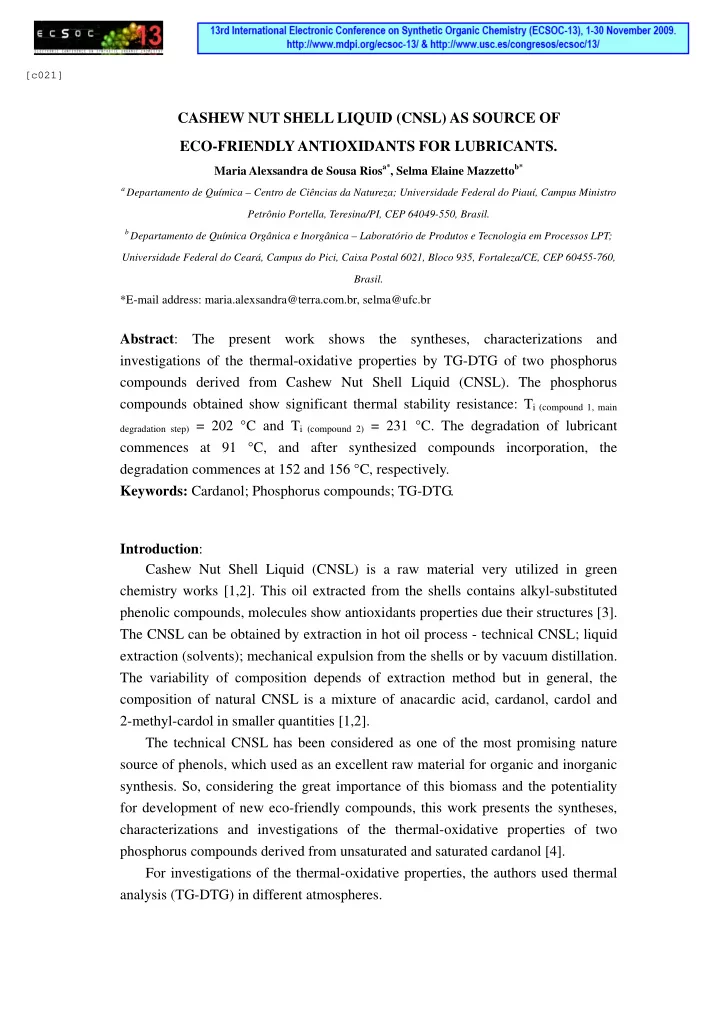

[c021] CASHEW NUT SHELL LIQUID (CNSL) AS SOURCE OF ECO-FRIENDLY ANTIOXIDANTS FOR LUBRICANTS. Maria Alexsandra de Sousa Rios a* , Selma Elaine Mazzetto b* a Departamento de Química – Centro de Ciências da Natureza; Universidade Federal do Piauí, Campus Ministro Petrônio Portella, Teresina/PI, CEP 64049-550, Brasil. b Departamento de Química Orgânica e Inorgânica – Laboratório de Produtos e Tecnologia em Processos LPT; Universidade Federal do Ceará, Campus do Pici, Caixa Postal 6021, Bloco 935, Fortaleza/CE, CEP 60455-760, Brasil. *E-mail address: maria.alexsandra@terra.com.br, selma@ufc.br Abstract : The present work shows the syntheses, characterizations and investigations of the thermal-oxidative properties by TG-DTG of two phosphorus compounds derived from Cashew Nut Shell Liquid (CNSL). The phosphorus compounds obtained show significant thermal stability resistance: T i (compound 1, main degradation step) = 202 °C and T i (compound 2) = 231 °C. The degradation of lubricant commences at 91 °C, and after synthesized compounds incorporation, the degradation commences at 152 and 156 °C, respectively. Keywords: Cardanol; Phosphorus compounds; TG-DTG. Introduction : Cashew Nut Shell Liquid (CNSL) is a raw material very utilized in green chemistry works [1,2]. This oil extracted from the shells contains alkyl-substituted phenolic compounds, molecules show antioxidants properties due their structures [3]. The CNSL can be obtained by extraction in hot oil process - technical CNSL; liquid extraction (solvents); mechanical expulsion from the shells or by vacuum distillation. The variability of composition depends of extraction method but in general, the composition of natural CNSL is a mixture of anacardic acid, cardanol, cardol and 2-methyl-cardol in smaller quantities [1,2]. The technical CNSL has been considered as one of the most promising nature source of phenols, which used as an excellent raw material for organic and inorganic synthesis. So, considering the great importance of this biomass and the potentiality for development of new eco-friendly compounds, this work presents the syntheses, characterizations and investigations of the thermal-oxidative properties of two phosphorus compounds derived from unsaturated and saturated cardanol [4]. For investigations of the thermal-oxidative properties, the authors used thermal analysis (TG-DTG) in different atmospheres.
Experimental procedure : The phosphorus compounds were synthesized by nucleophilic substitution (S n 2). The stoichiometry ratio of the reaction system was of 1.0 mol of unsaturated or saturated cardanol/1.0 mol of sodium hydroxide/1.0 mol of diethyl or diphenyl chlorophosphate, respectively. The reagents were dissolved in chloroform (20 mL), and the mixture was heated under reflux system with constant agitation at 60 °C (± 1 °C) during 2h, until the reaction was completed (monitored by thin-layer chromatography) [2]. After the reactions time, two viscous yellow oils were obtained. The lubricant (CAS 64742-53-6) was supplied by Petrobras (Brazilian Oil Company, Brazil) with no further distilled procedure. GC-MS analysis was carried out using a Hewlett-Packard 5890 and a Hewlett-Packard 5971A mass selective detector, on a dimethylpolysiloxane (DB-5) column. Sample of 1 μ L was injected into the column. Thermogravimetric (TG-DTG) measurements were performed at scanning rate of 10 ºC/min, samples of approximately 10 mg were heated from 25 to 900 ºC. The samples were carried out at nitrogen and synthetic air atmosphere (50 mL/min). Results and discussion : GC-MS profiles show the appearance of characteristic peaks confirming the formation of the phosphorus compounds – 534 g/mol (1) and 536 g/mol (2), respectively. The synthesized compounds exhibit the good thermal stability, Figures 1 and 2. These behaviors can be explained for the presence of a high aromatic content and the highly stable P-O-C bond. Table 1 shows the TG-DTG data of the compounds. 100 -1,2 Phosphorus compound 1 90 Nitrogen - atmosphere -1,0 80 70 -0,8 Weight loss (%) dm/dT (mg / 60 50 -0,6 40 o C) -0,4 30 20 -0,2 10 0,0 0 0 100 200 300 400 500 600 700 800 900 o C Temperature Figure 1: TG-DTG curves of phosphorus compound 1 (Nitrogen atmosphere).
100 Phosphorus compound 2 90 Air - atmosphere Nitrogen - atmosphere 80 70 Weight loss (%) 60 50 40 30 20 10 0 0 100 200 300 400 500 600 700 800 900 o C Temperature Figure 2: TG-DTG curves of phosphorus compound 2 (Air, nitrogen atmospheres). Table 1. TG-DTG data of compounds 1 and 2 in air atmosphere. Degradation step Degradation temperature Mass loss Residue Sample (n°) (°C) (%) (%) T i T f I 28 199 7 Compound 1 2,5 202 735 90,5 II I 231 422 83,5 Compound 2 3,5 II 427 764 13 T i , initial degradation temperature; T f , final degradation temperature; The thermogram and derivative thermogram of lubricant oil show that, the degradation commences at 91 °C and ending 309 °C probably due to elimination of low molecular weight products, followed by hydrocarbons degradation. After synthesized compounds incorporation, the degradation of lubricant commences at 152 and 156 °C, respectively. These results prove the antioxidant activity of the synthesized compounds. References : [1] Maria ARF, Selma EM, José OBC, Glaucione GB. Evaluation of antioxidant properties of a phosphorated cadanol compound on mineral oils (NH10 and NH20). Fuel 2007; 86: 2416-21. [2] Maria ARF, Síntese e Aplicabilidade de Antioxidantes derivados do Cardanol hidrogenado. Thesis (Doctor), Organic and Inorganic Chemical Department,
Federal University of Ceará, Brazil 2008. [3] Maria ASR, Francisco AMS, Selma EM. Study of antioxidant properties of 5- n -pentadecyl-2- tert -amylphenol. Energ Fuel. 2009; DOI: 10.1021/ef800994j. In Press. [4] Corneliu H, Tachita VB, Oana P, Gabriela L. Kinetics of thermal degradation in non-isothermal conditions of some phosphorus-containing polyesters and polyesterimides. Eur. Polym. J. 2007; 43: 980-8.
Recommend
More recommend